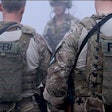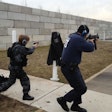Spring is starting to bust out all across America, and with it comes the annual rite of Spring known as "busting out" after being cooped up all winter. For most persons, this is a time to enjoy wholesome outdoor physical activities.
However, for the criminal element, Spring "bust out" means it's time to prey on the innocent. When the weather breaks, many locales experience dramatic rises in crime, violence, vehicle crashes, school violence, etc. All of which combine to create crime "surges" that keep police running from incident to incident. Oftentimes, to the point of overwhelming understaffed LE agencies.
Lately, much has been said about a new term to describe a longtime law enforcement strategy. The new term is "surge," and is borrowed from the military's successful strategy in Iraq that is about to also be employed in Afghanistan.
Law enforcement "surges" have been around for decades—only called by different names. Crime suppression, hitting hot spots, saturation patrol, high-crime area targeting are among the many names for essentially the same strategy.
This strategy harnesses manpower and resources into larger than normal groups of officers who enforce violations in select target areas to take them back and clean them up, and make these areas safe for citizens.
This is far from new, and many years ago as a rookie, I can recall the old timers talking about the "old days" when squads of officers would conduct Friday night preventive sweeps of known "trouble" bars. They'd arrest known criminals, those with warrants, weapons, and drugs, or simply "suspicious persons," hold them for 72 hours, and release them without charges Monday morning.
These Friday sweeps proved highly effective in reducing weekend crime. Times changed, and this tactic disappeared years ago. But not entirely—particularly in high-crime areas of urban areas.
Known by names such as high-crime and saturation patrol, spring offensives, and more recently crime suppression, sweeps consist of LE task forces that often include SWAT, Gang, and Narcotics officers who target known "hot spots" selected by computer analysis of targeted criminal street activity—including drugs and gangs.
LE task forces often consist of SWAT, Narcotics, Gang, Traffic, Patrol, prisoner wagons, and booking officers. Task forces move from "hot spot to hot spot" with undercover spotters providing crime intel, arresting, citing, and towing as they go.
Some sweeps are accompanied by search warrants. For open areas (parks, playgrounds, street corners, etc.) "hammer and anvil" is a highly effective tactic. The "hammer" is one or more units (marked or unmarked) that drive directly at the criminal activity, but not necessarily getting into foot chases. The "anvil" is situated on the opposite side of the "hammer" and is where the bulk of the cars and personnel are situated.
Suspects usually flee from the "hammer" and head straight for the officers in the "anvil." This tactic drastically reduces foot pursuits, and increases the number of apprehensions. Very often, after such sweeps, Patrol benefits from the mere presence of any subsequent police car that will cause the location to clear out.
Some targeted areas are so "hot" that sweeps are sometimes also accompanied by search warrants. The following example illustrates how this works:
In a large Midwest city, open crime, drugs, gangs, etc., was out of control in a large public housing complex. Patrol officers worked two-officer cars, and would only enter the complex with one or more backup cars. Suspects routinely ran into the complex, scattering in all directions. This would immediately attract large crowds hostile at the presence of police.
This "cat and mouse" game became so frequent as to become expected. Soon, things began to heat up, with verbal taunts, threats, and thrown objects targeting police. Then came the shots fired—within earshot, but just out of sight—sending a "message" to police.
The shots fired increased in frequency and volume, despite multiple-car police presence. The situation was definitely heating up, finally including automatic weapon fire. One night Patrol heard lengthy automatic weapon fire, and found more than 100 empty casings.
It was only a matter of time before police would become the next targets. Patrol requested assistance from SWAT, who in turn conferred with Narcotics and learned Narcotics was in the process of obtaining three search warrants within the complex.
SWAT, Narcotics, and Patrol combined into a task force to execute the three warrants and sweep the complex and the adjacent area. The complex consisted of four buildings forming a square, with a central courtyard and two openings for access large enough to drive a vehicle through.
The tactical plan was SWAT would execute the three search warrants simultaneously while deploying two CST (sniper teams) and drive the ARV into the courtyard to cover the operation.
Simultaneously, Narcotics and Patrol would handle containment and conduct street sweeps of the complex and adjacent streets. The plan required precision timing and coordination and flawless execution—which is exactly what happened.
The entire complex was effectively "locked down," numerous arrests were made, and numerous weapons and large amounts of drugs were seized. End of problem—no more shots fired, dealers arrested, the complex made safe for residents—along with "message sent" to the bad guys about who really "owned the streets."
With Spring upon us, if your jurisdiction has "hot spots" that need special attention, harnessing your resources into task forces employing sound tactics will pay huge dividends. Many LE agencies have effectively employed sweeps as an annual rite of Spring passage. And most will agree: Where sweeps go, the bad guys go away.












